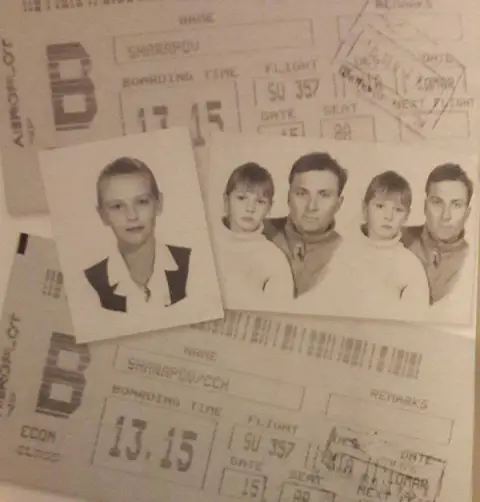If you follow Women’s Tennis Blog on Instagram, you know that last week I received my copy of Maria Sharapova’s autobiography “Unstoppable”. I read it in a couple of days and even though I had already known the defining events in the Russian’s life path, the book has given me more detailed insights, with some stunning new facts that make me appreciate the tennis star’s success even more and watch her matches with better understanding of the depth of the story behind them. In this post I’ll share with you my favorite parts of the memoir.

Everything starts with this amazing photo of Masha’s and her father’s venture into the unknown, their first trip to Florida, with just $700 and determination to make it. When you read the book and Masha’s uncertain and rocky path, you absolutely understand the captivating force behind her fighting spirit and that icy look she has in the defining moments of important tennis matches.

I have always believed that unforgiving routine and sacrifice are crucial factors in every success, rather than just talent, whatever talent is, and Sharapova absolutely confirms that in describing how people first started noticing her tennis.
It was not my skill that people remarked on. It was my concentration — that I could do it again and again without getting bored.
And also this quote of Masha’s first coach, Yuri Yudkin, whom Sharapova met while living in Sochi.
To be great at anything, you have to be able to endure a tremendous amount of boredom.
I won’t retell the story here, but in a nutshell, to give you a timeline, shortly before Masha was conceived, there was the April 1986 Chernobyl nuclear catastrophe, near Gomel, Belarus, where her parents Yuri and Yelena lived. Because of the life-threatening disaster, Yuri and Yelena moved as far as they could, to Nyagan, “a shitty little town” as Yuri calls it, and that’s the now famous Siberian town where the tennis champion was born. When Masha was two years old, they moved to Sochi, Russia, where they still own an apartment in Vishnevaya Street, on the sixth floor. Since Sochi is a resort and tennis is part of its life, unlike elsewhere in Russia, Maria concludes:
If you had to pick one event that made me a player, it’d be Chernobyl.

Based on Yudkin’s and later Martina Navratilova’s advice that in order to realize her potential Masha simply had to move to America, Yuri Sharapov listened to his gut and took the plunge, miraculously completing the difficult visa procedure and bravely going to Florida, knowing that his six-year-old daughter would not be able to see her mother for years, because of the visa restrictions, and that he would be paving the path alone and broke in the unfamiliar world, without even speaking English. Then came the disappointment in the Rick Macci Tennis Academy in Boca Raton and the eventual acceptance in the Bollettieri Tennis Academy in Bradenton, on the other coast of Florida.
In the meantime, Masha even had to change her name to better adapt to the new environment:
Maria is not my real name. I was christened Masha. But there is no good match for Masha in English, and soon after I arrived in America, people started calling me Marsha, which I hated — they connected me to the Brady Bunch! — so I got out in front of that and told people to call me Maria.
Settling in Florida was just the beginning of the long journey full of disappointments, poverty, hard work, struggle, and fear of the ever-lurking failure, until everything set into place when Masha signed with IMG and the way she explains the major change that happened then really makes you understand the story behind her awe-inspiring business sense.
Being at IMG changed everything for us. For the first time, we did not have to worry about food and rent. If something went wrong, we could go to a doctor. If there was a tournament, we had our own means to get there, so I could focus on tennis. This money coming in — it taught me something. It was like I suddenly woke up to the truth of the world. For the first time, I sort of understood what it was all about. Tennis is a sport but it’s not just a sport. It’s a passion but it’s not just a passion. It’s a business. It’s money. It’s stability for my family, I got it now.
Maria was quite open about her crushes and relationships in the book. She mentions her first crush to be on a guy who was then Barbora Strycova’s boyfriend, while in the period of her groundbreaking 2004 Wimbledon triumph she was fascinated by Juan Carlos Ferrero.

However, her first serious relationship was with Slovenian-born basketball player Sasha Vujacic in 2009, to whom she was even engaged, but things got sour, as Maria explains, mainly because she was more successful, famous and wealthy than her man and that’s never a good foundation for a relationship, especially a long-distance one.
In October 2012, after her quarterfinal match in Beijing, Masha’s agent Max Eisenbud sent her a message: “Grigor Dimitrov wants your number.” The Bulgarian, who was still playing qualifying ATP rounds at the time, was kind, cute, and gave Masha just the right kind of attention, so they started dating, with Masha witnessing his rise in the rankings, status and transformation from boyhood to manhood. When you read how Masha describes Grigor, you get a feeling of warmth and acceptance, so I think the only reason they are not together any more is that the relationship happened at the wrong time in Masha’s career.

I also like it how Masha breaks down why it’s hard for a successful athlete to find the right partner:
You’re never home, so the only way you can have a relationship is either with another tennis player, a player also on the tour, or with a person who gives up his life to travel with you, becoming part of your entourage. And who does that? Someone without a life of his own? That is, someone you’d probably not want to date in the first place. These sorts of characters do exist. You see them in the players’ lounges or carrying bags. Not the coach, not the parent, but the boyfriend. By definition, any relationship you have is going to be long distance, which amounts to a kind of a telephone buddy or pen pal. Not terribly exciting.
The book made me appreciate Maria’s success even more and has inspired me to pursue my goals with greater determination. It’s an easy and fun read and I definitely recommend it to everyone, especially tennis fans.








I really love Maria Sharapova especially her attitude. I started playing tennis because I was inspired by her story as much as I was inspired by Ana Ivanovic. I remember watching her matches when she was just on a rise. She has that natural appeal and talent that you can’t resist. Even when she was losing especially on her injury prone days, I still support her because she’s a great fighter and if there’s one thing I learned about Maria, you never concede a match without a good fight. I hate losing and I’m kind of a perfectionist. Maria taught me that I need to fight for everything with the best of my abilities.